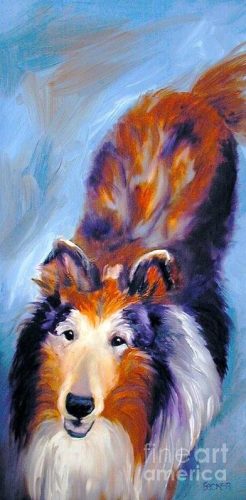
He painted Cocker Spaniels and a Poodle, Fox Terriers and Beagles. An English Springer Spaniel, Scottie and Bulldog were included, and we can’t forget the Chocolate Lab, Dalmatian, Basset Hound, or Irish Setter. Norman Rockwell painted the American Dream better than anyone, and Americana wasn’t complete without a dog. The aforementioned breeds were among those he rendered, many of them appearing on his Saturday Evening Post covers.
Rockwell loved dogs, and they were often important design elements of his work. But they were also a vehicle for portraying a message. A good example is found in the canvas painted in 1954, “Breaking Home Ties.” Take a good look at the piece. It illustrates a young man heading off to college, and as it was painted the same year Rockwell’s own three boys had left home, the artist was sensitive to the impending emptiness felt by the boy’s father. Norman later wrote that most of the fan letters he got about the painting had to do with the dog described as a Collie. He also revealed his thinking in creating the piece: The father wouldn’t reveal how he felt about his son leaving, but the dog could. It was a marvelous way to maintain the father’s strong, silent ruggedness while transferring his feelings to the Collie who easily expressed what the man felt. Filmmakers, George Lucas and Steven Spielberg, fans and collectors of Rockwell’s work, had it right when they said they considered Rockwell’s art as “cinematic” for its ability to tell an entire story in a single image. Understandably, “Breaking Home Ties” was the second most popular of Rockwell’s Post magazine covers, the first having been Saying Grace.
“Breaking Home Ties” wasn’t the only time Rockwell had included a Collie in a Saturday Evening Post cover art.
“Boy with Two Dogs” was the cover of the September 29, 1929 issue, and one of the dogs was a Collie preparing for travel. The “R” around the Collie’s neck was a subliminal message, a wink and a nod, if you will. This was “Raleigh Rockwell,” Norman Rockwell’s own dog. The narrative portrays a young “Huck Finn” type of boy, and perhaps he is running away from home with his own dog. He has stopped to pet the Collie, but the time period in which the painting was made is important. It pre-dated the stock market crash that ushered in the Great Depression, but a downturn in the economy had already begun, and this is evident in the boy’s torn hat and pants, and his lack of shoes. His hands are dirty, as is his dog, but his interaction with a fine pedigreed dog hints that there are still people of means about, and that the boy may yet grow up to be one of them. It was a difficult, but simpler time, and Rockwell used the juxtaposition of dogs to impart the message. Brilliant.
Norman Rockwell’s former brother-in-law, Howard O’Connor, told of how Norman once had to leave Raleigh behind to attend to business in Europe. Raleigh mourned his master terribly, so much so that there were fears the dog would die. When Norman returned home, he hand fed Raleigh every couple of hours for days. Raleigh eventually put on weight, regained his health, and grew perky again. Raleigh’s whiskers, however, remained white, droopy, and pathetic looking. As the story goes, Norman told his dog, “Listen, Raleigh, I promise I’ll never leave you alone again if you just let the whiskers get back to their natural color.’”
Within weeks, Raleigh’s whiskers darkened, and as promised, Norman Rockwell never left him again.
Collies appeared on several Saturday Evening Post covers. There was the Saturday Evening Post cover from 1927, Dogs Life by Robert L Dickey, and one by Howard Van Dyke from 1933. “Dog Days of Summer” by John Clymer appeared on a cover in 1955, and his “Swimming in the Creek” was done in 1959 (some say this is a Border Collie). Clymer also did “Gathering Wood” in 1961; From 1953, Stevan Dohanos’ Saturday Evening Post cover, New Dog in Town.
We won’t think any of these Collies told a story the same way that Rockwell’s Collies did, but art is subjective and that’s just our opinion.
Norman Rockwell died in Stockbridge, Massachusetts in 1978 due to complications of pulmonary emphysema. The year before, he had received the Presidential Medal of Freedom, the most prestigious civil award in the United States.
In an era of digital photography, deep fakes, AI generated art, and photoshop, we will never see the likes of Norman Rockwell again because, perhaps, society doesn’t need them. Nostalgia probably plays a part in our appreciation of Rockwell’s unpretentious portrayals, what some would call syrupy sentimentality. Still, he painted how he saw things, and subtly highlighted details others might not have noticed by using a dog to express them.
Norman Rockwell’s last dog was a loveable Beagle mix,
Image: Rough Sable Collie by Susan A Becker is available as fine art, and in home decor and lifestyle items here.
